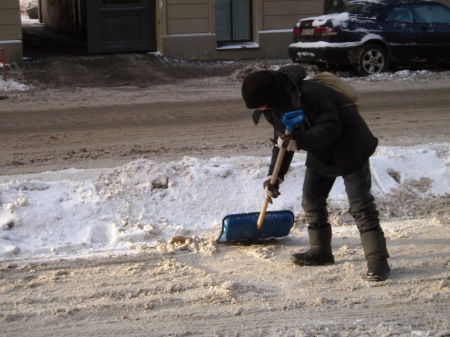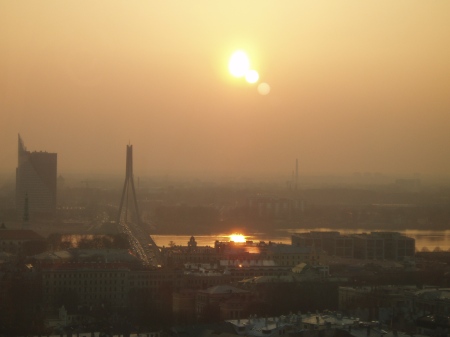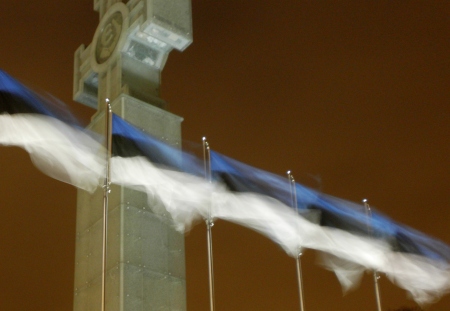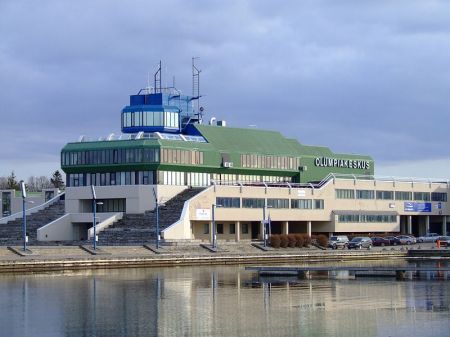For evening meal we choose the out-of-town Lido amusement park where we had been before on our previous visit. Kim was certain that it was a very precise eight-minute walk but we were all pleased that we overruled her and took the twenty-minute taxi ride instead.
The Lido looked wonderful, there was a skating rink with people enjoying themselves on the ice, someone had forgotten to switch off the Christmas lights and the whole place was like a huge fairy grotto made all the more impressive with the liberal covering of snow below our feet and a clear velvet black sky above our heads. Inside there was a sumptuous display of self service fare all carefully arranged by meat types which to be honest only vaguely assisted selection, faced as we were by an overwhelming choice of food.
This place didn’t seem to fit the vision of Latvia as being a place to get away from and move to the east of England instead. I know that with the lowest average wage it is officially the poorest country in the EU, and for that reason tens of thousands of Latvians have left for England where they can earn as much in a week as they earn in a month back home but this place was lively and vibrant, the food was excellent and inexpensive, and the customers seemed affluent and happy. With women in stylish fur coats and extravagant high heel boots none of this seemed consistent with tales of migrant worker woes back home!
The journey back to the hotel was one of the highlights of the holiday! We left the Lido and looked for a taxi and it was just our luck to select one with a lunatic escaped from an asylum for a driver. When it comes to taxi drivers we certainly can pick them.
Kim made the first approach and asked if he could take some of us back to Riga and to our surprise he indicated that he could take all five of us in his Renault Megane.
This was a vehicle that was clearly unsuitable for accommodating five passengers and probably not licensed to do so either! Kim doubted this and just for clarification enquired a second time and clearly running short on patience he gave her his “why can’t this stupid woman understand look”, and immediately increased his carrying capacity to an absurdly optimistic eight! Kim looked even more startled by this and even examined the interior of the car for concealed seats by sticking her head through the open window. He responded by raising his eyeballs so far into the top of his head that if he’d had laser vision he would have fried his brains. This was our cue to accept the five in a taxi invitation and we piled in.
Then the fun really started! He immediately quizzed us about our national origins: “Where are you from?” He enquired, “England” said Micky, “London?”he followed up. This is a standard opening conversation with a European taxi driver that frequent travellers will be familiar with; the only place they really know in England is the capital, and sometimes Manchester, so they always make reference to it “No, Lincolnshire” Micky informed him without managing to raise a flicker of recognition and immediately closing down this topic of conversation.
Taxi driver “Do you know Tony Blair?”, Micky “Well, not personally, no”
The scary driver went on to explain how from his personal perspective life was desperately unfair in Latvia. From his explanation of conditions we discovered that he was a Russian living in Riga and by his own self-assessment suffering all sorts of discrimination (which is hardly surprising really when they (the Russians) had spent forty years or so kicking the shit out of the place). His solution to the problem was the advocacy of a red revolution and I for one thought it sensible not to disagree too robustly. He spoke with a thick Russian accent and had the unfortunate habit of preceding each statement with an unpleasant phlegmy hack that was half cough and half retch and definitely only half human.
“Times are hard, it is very expensive to live in Riga”, “No way” said Micky, half mocking him now, “This place is very reasonable!” This led to a few seconds of choking laughter and uncontrollable hacking by the driver and after a few more cost of living exchanges Micky, fully mocking him now, did eventually concede that life was getting a bit tougher in the west; “Yes,” he said “I have to agree, things are getting harder in England too, look at us, we used to have two wives each but now we can only afford one and a third to share between us!”
Then the driver lamented that it would cost him a month’s wages to stay three nights in a Riga hotel and again Micky put him straight and corrected his estimate to just the one night. This man was good fun and he even thought it was amusing when we directed him to the wrong hotel and he had to make readjustments to his route to get us to our intended destination. And it only cost ten Lats, that’s what I call good value, a taxi ride, conversation and excellent entertainment thrown in.
Actually Russians have had a bit of a hard time since independence because when Latvia broke free in 1991, it granted automatic citizenship to those who had lived in the first independent Latvian state, between 1918 and 1940, but not to those who immigrated here after the war, when Latvia was occupied by the Soviet Union.
Under Soviet rule during the Stalin years thousands were arrested and sent to Siberian labour camps, or executed. Later, hundreds of thousands of Russians, Belarussians and Ukrainians flooded into the republic under a deliberate policy of Russification. The Latvian language was squeezed out of official use. Latvians were resentful citizens of the USSR and by 1991 they comprised only half of the population of their own country, while in Riga only a third were Latvian.
Today Latvia is determined to revive the national identity. It says that its policy towards Russians who immigrated there during the Soviet period is aimed not at punishing them for the ‘crimes’ of the Soviet regime but at ensuring that they learn Latvian and integrate fully into society. In order to naturalise, Russians must take a test in Latvian, and pass an exam about Latvian history in which they must ‘correctly’ answer that the country was occupied and colonised, not liberated, by the Soviet Union in 1945.

__________________________________________________
More posts about Riga…
Rosa Klebb’s endurance sightseeing tour of Riga
Latvia Dining – a Chronic Case of Indecision
Riga – Festival of the Family and a BBQ
_______________________________________________
















